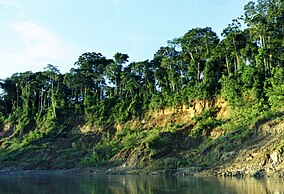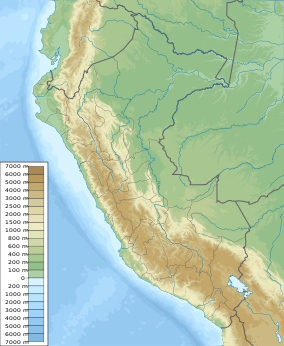Manú National Park
Manú National Park is a biosphere reserve in Peru.
| Manu National Park | |
|---|---|
IUCN category II (national park) | |
 View of a riverbank in Manu National Park | |
| Location | Madre de Dios Region, Cusco Region |
| Nearest city | Cusco |
| Coordinates | 11°51′23″S 71°43′17″W / 11.85639°S 71.72139°W |
| Area | 17,162.95 km2 (6,626.65 sq mi) |
| Established | May 29, 1973 (by 644-73-AG) |
| Governing body | SERNANP |
| Website | Parque Nacional del Manu |
| Criteria | Natural: (ix), (x) |
| Reference | 402bis |
| Inscription | 1987 (11th Session) |
| Extensions | 2009 |
Before becoming an area protected by the Peruvian government, the Manú National Park was conserved because it was inaccessible; that is, people could not get to it. The park is fairly inaccessible by road to this day. In 1977, UNESCO recognised it as a Biosphere Reserve and in 1987, it was named a World Heritage Site.
It is the largest National Park in Peru, covering an area of 15,328 km². The Biosphere Reserve includes an additional 2,570 km², and a further 914 km² are included in a "Cultural Zone" (which also given protection), bringing the total area up to 18,811 km².
The park protects several ecological zones ranging from as low as 150 metres above sea level in parts of the Amazon Basin, to Puna grassland at altitudes of 4200 metres. Because of this topographical range, it has one of highest levels of biodiversity of any park in the world.
Overall, more than 15,000 species of plants are found in Manú, and up to 250 varieties of trees have been found in a single hectare.
The reserve is visited by birdwatchers from all over the world, as it is home to over 1000 species of birds. This is over 10% of all living bird species,[1] and more than the number of bird species found in the entirety of North America.
The Park has one of the most varied collections of land vertebrates ever found in Latin American tropical forests.[2]
References
change- ↑ Courtney, Julia. 1989. Sir Peter Scott: champion for the environment and founder of the World Wildlife Fund. Stevens, Milwaukee. ISBN 1-55532-819-9
- ↑ Endo, Whaldener et al. 2010. Game vertebrate densities in hunted and nonhunted forest sites in Manu National Park, Peru. Biotropica 42:251-261. DOI 10.1111/j.1744-7429.2009.00546.x
